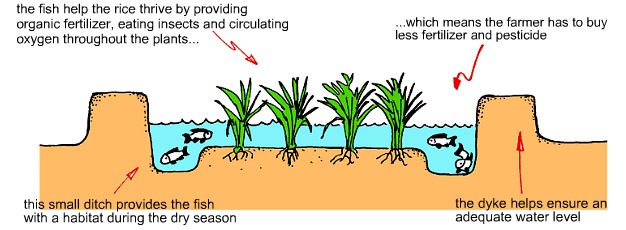Rice-fish culture involves farmers introducing another ‘crop’ into their rice fields – small, indigenous fish. This technique is good for both the fish and the rice. Safely hidden from birds, the fish thrive in the dense rice plants, while they in turn provide a source of fertilizer with their droppings, eat insect pests and help to circulate oxygen around the rice field. Farmers tell us that keeping fish in rice fields can increase rice yields by up to 10% – plus they have the additional supplies of fish.
These lifesaving crops are doubly good for poor families struggling to deal with the global food crisis. A diet of fish is an excellent source of protein and so improves people’s health. Extra rice yields, meanwhile, not only put meals on tables but enable families to sell surplus food at market. Practical Action has helped to spread this technique in Bangladesh.
Construction
Firstly, Practical Action works with a farmer to identify a suitable site: one that is less likely to be washed away should a flood occur. Together we then build a dike approximately 60cm high around the outskirts of the field. This has a dual purpose – to keep the fish in the rice fields and enable vegetable cultivation around the field. The next step is digging a ditch for the fish to live in during the dry season – this is something the whole family can get involved in.
Planting and Stocking
The farmer plants the rice in rows that are roughly 35cm apart, then fills 50% of the ditch with water. The water is purified with a small quantity of lime, and a little organic fertilizer is added. Then, when the rice starts to shoot, the water level across the field is increased to 12–15cm, and small fish or ‘fingerlings’ are released into the ditch. As soon as they have acclimatized to the rice field water, the farmer releases them into the field and raises the water level as both the fish and rice grow.
Harvesting
Come the first harvest, approximately 4–5 months later, the farmer will harvest the rice first, and then drain the rice field to collect the fish into the ditch where they can easily be caught. In areas where Practical Action has helped people to develop rice-fish culture, farmers have reported a 10% increase in rice yields, plus enough fish to provide regular, high-protein meals for their families.

Source and Photo: www.practicalaction.org